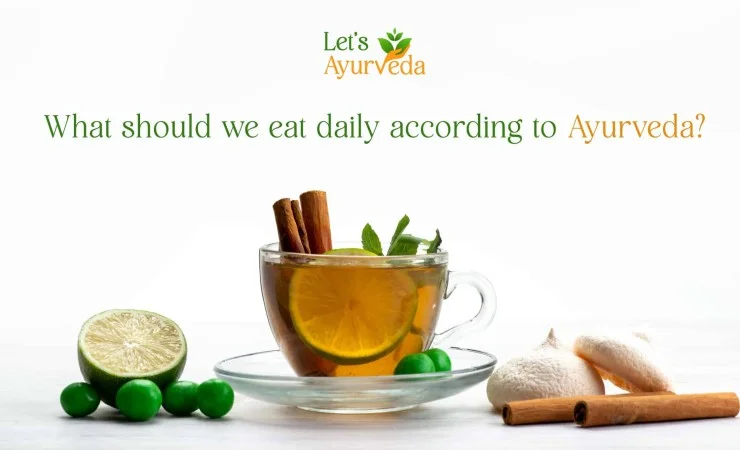Diet has long been a critical component of Ayurveda's approach to promoting physical and mental wellness. Ayurveda established guidelines for putting Hippocrates' counsel to use, "Let food be thy medicine," into practice hundreds of years before Hippocrates spoke it.
Choice of food, the timing of meals, and the level of attentiveness during meals either boost Ojas (vitality) or decrease ama (toxicity). The Ayurvedic tradition of using food to promote health, vitality, and energy can be accessed by following the guidelines listed below.
Based on your dosha type, choose foods-
According to Ayurveda, each individual has a unique mind-body composition or dosha. A person's current doshic imbalance, or vikruiti, combines two magnified physiological elements. Eating meals that lower the heightened components can restore harmony with the body.
Delete the snacks-
After a meal, the three phases of digestion must be finished following Ayurvedic principles. The Kapha energies rule the first hour following a meal. After that, the body could feel sated, hefty, and complete. Next, digestion is controlled by Pitta elements two to four hours after a meal.
During this time, the body produces more hydrochloric acid, the temperature rises, and food is converted to energy. Finally, the Vata energies increase four to five hours after a meal. During this period, appetite grows, and space and lightness return.
Eat till full; if not satisfied-
Consider your stomach a gas gauge with a scale of one to ten. On that measure, one is empty, while 10 is excessively full. You should eat when you reach a two; when you get a seven, you should stop. You risk disrupting the digestion cycle if you eat before the number two. In addition, overeating takes a significant amount of energy away from vital physiological functions.
In addition to contributing to weight gain, overeating boosts the body's generation of free radicals, accelerating the aging process. You prevent overeating by putting down the fork when full but not stuffed. The body gets the nutrition without working extra hard to digest and sometimes storing extra calories.
Consume natural, fresh meals-
In its basic form, prana—your life force—nourishes the body and is the source of all health, vigor, and vitality. It is distinct from food. The various nutrients found in food, including its vitamin, mineral, and phytonutrient content, are merely reflections of the pranic imprint.
According to the Ayurvedic diet, raising ojas, the body's source of life force is best accomplished through increasing prana. Foods high in prana come straight from the earth. Their prana is created when the energies of the sun, the water, and the world combined.
Minimize Disruptions While Eating
How often do you eat as you watch TV, read a book, check your emails, or make calls? If you're like most people, you'll reply, "Quite a few." The Ayurvedic diet holds that eating is an opportunity to communicate with the food's innate intelligence and vitality. Emphasize the colors, flavors, earthy soil, sunshine, and earth that created the food's energy-dense bundles.
Start by eating just one meal each day quietly and spending a few minutes focusing on each sense if you need to get used to eating with great awareness.
Stop eating three hours before night-
The body restores, heals, and refills as the mind processes the previous day's memories and emotions. If the body's energy is directed toward physical digestion, mental digestion, and physical healing are obstructed.
Ayurveda medicine recommends that the day's final meal be relatively light and finished three hours before night to avoid this imbalance. As a result, your body's natural ability to relax and repair itself at its lowest levels happens when you sleep.
Choose herbal teas to drink throughout meals-
Tea is a potent healer that can help restore health, vigor, and joy, and it is a tasty beverage. Beverages, particularly teas, should be eaten sparingly with meals (no more than 1/2 cup) to prevent agni from diluting.
However, teas can be consumed freely between meals and serve as herbal cures. In addition, tea consumption between meals provides the body with "liquid medication," stoking the digestive fire and reducing snack cravings.
Warm, spicy teas with cinnamon, ginger, and cloves will ground and soothe Vata doshas. Cooling herbs like peppermint, coriander, and rose are balanced for Pittas, who can drink hot or cold tea. You will have more energy, better digestion, and optimism with licorice, black pepper, and cardamom.
Consider lunch to be the main meal of the day-
Agni is most vital when the sun is at its highest. When the largest meal of the day is eaten at noon, the body may use its powerful internal fire to break down and digest nutrients with less energy production than at other times. The lunchtime meal is the best time to include heavier or harder-to-digest foods.
Additionally, it is the ideal time to treat yourself to a wonderful supper (think an icy drink or sugary treat). By having the heaviest meal at midday, the body will have plenty of energy to last throughout the afternoon, reducing the "afternoon energy dip."
These age-old Ayurvedic prescriptions will help you maintain good health regarding your food and how you eat it. And remember to appreciate the food you eat along the way by enjoying each meal.






